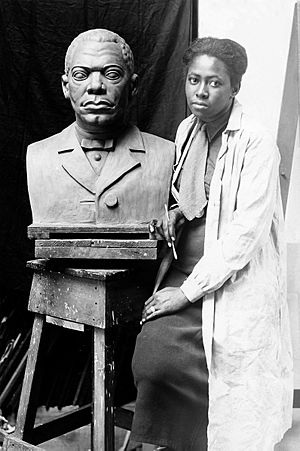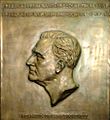Selma Burke facts for kids
Quick facts for kids
Selma Burke
|
|
|---|---|

Burke with her portrait bust of
Booker T. Washington, c. 1935 |
|
| Born |
Selma Hortense Burke
December 31, 1900 |
| Died | August 29, 1995 (aged 94) |
| Nationality | American |
| Education | Columbia University, Winston-Salem State University |
| Known for | Sculpture |
| Awards | Women's Caucus for Art Lifetime Achievement Award, 1979 |
Selma Hortense Burke (born December 31, 1900 – died August 29, 1995) was an American sculptor. She was an important member of the Harlem Renaissance movement. Burke is most famous for a special kind of portrait called a bas relief. This portrait was of President Franklin D. Roosevelt. Many believe it was used as the model for his image on the dime coin. Selma Burke called herself "a people's sculptor." She created many pieces of public art, often showing important African-American people. These included figures like Duke Ellington, Mary McLeod Bethune, and Booker T. Washington. In 1979, she received a special honor, the Women's Caucus for Art Lifetime Achievement Award. She once said about her life as an artist, "I really live and move in the atmosphere in which I am creating."
Contents
Who Was Selma Burke?
Selma Burke was born on December 31, 1900. She grew up in Mooresville, North Carolina. She was the seventh of ten children. Her father was a minister and also worked on railroads. When she was a child, she went to a one-room school. She loved playing with clay she found near her home. She later said that squeezing the clay was her first experience with sculpture. She felt like she "discovered me" in 1907.
Selma's grandmother, who was a painter, encouraged her interest in art. However, her mother wanted her to choose a job that was more stable. Her mother told her, "You can't make a living at that."
Selma's Early Life and Education
Burke went to Winston-Salem State University. In 1924, she graduated from the St. Agnes Training School for Nurses in Raleigh, North Carolina. She married a childhood friend, Durant Woodward, in 1928. Sadly, he died less than a year later. She then moved to Harlem, New York, to work as a private nurse. She worked for a very wealthy woman. This woman later helped Burke financially during the Great Depression. She became a supporter of Selma's art.
How Did Selma Burke Join the Harlem Renaissance?
After moving to New York City in 1935, Burke started taking art classes. She studied at Sarah Lawrence College. She also worked as an art model to help pay for her schooling. Around this time, she became part of the exciting Harlem Renaissance movement. This was a time when African-American art, music, and literature flourished. She was briefly married to the writer Claude McKay.
Burke began teaching art at the Harlem Community Art Center. This center was led by the sculptor Augusta Savage. Selma also worked for the Works Progress Administration (WPA). This was a government program during the Great Depression. One of her WPA projects was a sculpture of Booker T. Washington. It was given to a high school in Manhattan in 1936.
Studying Art in Europe
Burke traveled to Europe twice in the 1930s. First, she went to Vienna in 1933-34 to study sculpture. She went with a special scholarship. She returned in 1936 to study in Paris with a famous artist named Aristide Maillol. While in Paris, she met Henri Matisse, who praised her artwork.
One of her important works from this time is "Frau Keller" (1937). It is a portrait of a German-Jewish woman. Burke created it because of the rising Nazi threat. This threat convinced her to leave Europe later that year. When World War II started, Burke chose to work in a factory. She became a truck driver for the Brooklyn Navy Yard. She believed that during the war, "artists should get out of their studios."
After returning to the United States, Burke earned a scholarship. She went to Columbia University. She received her Master of Fine Arts degree in 1941.
Selma Burke's Teaching and Later Life
In 1940, Burke started the Selma Burke School of Sculpture in New York City. She was very dedicated to teaching art. She opened the Selma Burke Art School in New York City in 1946. Later, she opened the Selma Burke Art Center in Pittsburgh, Pennsylvania. This center was open from 1968 to 1981. It was an important art center in Pittsburgh. It offered many classes, from studio workshops to puppetry.
Burke used her art to bring people together. In her hometown of Mooresville, black children could not use the public library. Burke became famous and decided to donate a sculpture of a local doctor. She made it a condition that the library ban be removed. The town agreed.
In 1949, Burke married an architect named Herman Kobbe. They moved to an artists' colony in New Hope, Pennsylvania. Kobbe passed away in 1955. Selma Burke continued to live in her New Hope home until she died in 1995. She was 94 years old.
She also taught at several colleges. These included Livingstone College, Swarthmore College, and Harvard University.
What Kind of Sculptures Did Selma Burke Make?
Selma Burke created sculptures of famous African-American figures. She also sculpted everyday people. Her art explored human feelings and family connections. While she admired abstract art, her work focused on showing the human form. She wanted her sculptures to be both dignified and meaningful. She used many different materials. These included wood, brass, alabaster, and limestone.
Some of Burke's public sculptures include a bust of Duke Ellington. This is at the Performing Arts Center in Milwaukee. Her works are also shown at the Hill House Center in Pittsburgh. You can also find her art at the Schomburg Center for Research in Black Culture in New York City. Other places include Atlanta University, Spelman College, and the Smithsonian Museum of American Art. Her last large sculpture was made in 1980. She was 80 years old then. It is a bronze statue of Martin Luther King, Jr. in Charlotte, N.C..
Burke's art was shown in many exhibitions. She had solo shows at Princeton University and the Carnegie Museum. Her work is part of the collections at the Metropolitan Museum of Art and the Whitney Museum of American Art.
Selma Burke's Famous Portrait of President Roosevelt
Burke's most famous artwork is a portrait honoring President Franklin D. Roosevelt. In 1943, she won a national competition to create this sculpture. She made sketches during a 45-minute meeting with Roosevelt at the White House. Burke herself asked Roosevelt for a live sitting. The President agreed and met with her twice. He passed away before their third meeting could happen.
Roosevelt's wife, Eleanor Roosevelt, thought Burke made him look too young. But Burke replied, "This profile is not for today, but for tomorrow and all time." When asked about sketching the President, she said he moved too much. She told him to sit still, and he did!
The large portrait plaque was finished in 1944. President Harry S. Truman showed it to the public in September 1945. It is still displayed today in the Recorder of Deeds Building in Washington, D.C..
Many people believe that the image of Roosevelt on the Roosevelt dime was inspired by Burke's plaque. However, the coin designer, John R. Sinnock, said it was not. He pointed to his earlier works that looked similar. For example, Sinnock's 1933 medal of Roosevelt looks a lot like the 1946 dime. Both his 1933 and 1941 medals were made before Burke's bas relief.
Honors and Awards for Selma Burke
Selma Burke received many honors during her life. She was an honorary member of the Delta Sigma Theta sorority. She also received several honorary doctorate degrees. These included degrees from Livingston College in 1970 and Spelman College in 1988.
On July 29, 1975, the governor of Pennsylvania, Milton Shapp, declared it Selma Burke Day. This was to recognize her important contributions to art and education. Her personal papers and art records are kept at Spelman College.
In 1979, Burke was one of the first women to receive a Women's Caucus for Art Lifetime Achievement Award. Other famous artists like Louise Nevelson and Georgia O'Keeffe also received this award. President Jimmy Carter gave her the award in a private ceremony. She also received the Candace Award in 1983. In 1988, she got the Pearl S. Buck Foundation Women's Award. The Essence Magazine Award followed in 1989.
Her work was also shown in a special exhibition in 2015. It was called We Speak: Black Artists in Philadelphia, 1920s-1970s. This exhibition was at the Woodmere Art Museum.
When Did Selma Burke Die?
Selma Burke passed away at the age of 94. This was on August 29, 1995. She died in New Hope, Pennsylvania, where she had lived since the 1950s.
Images for kids
See also
 In Spanish: Selma Burke para niños
In Spanish: Selma Burke para niños






